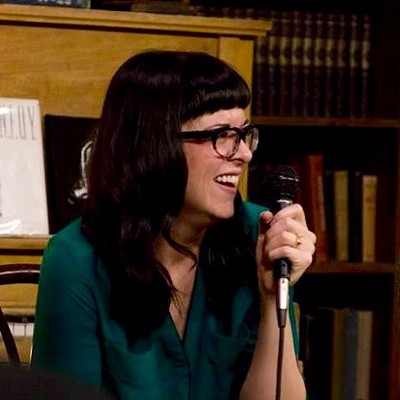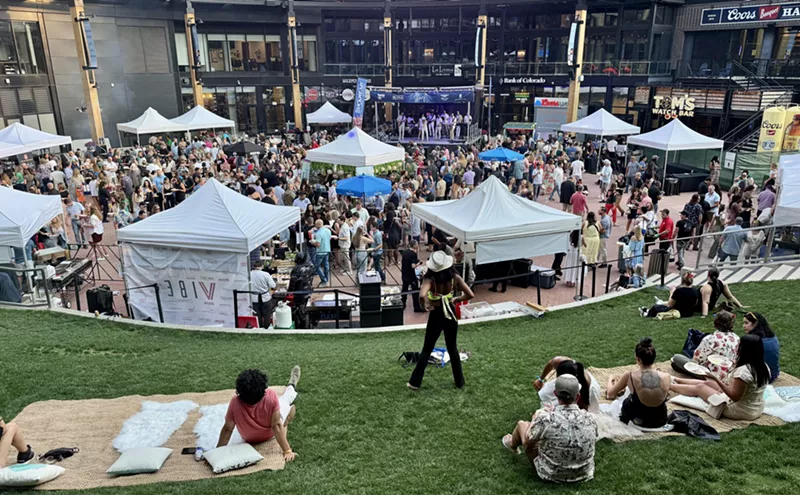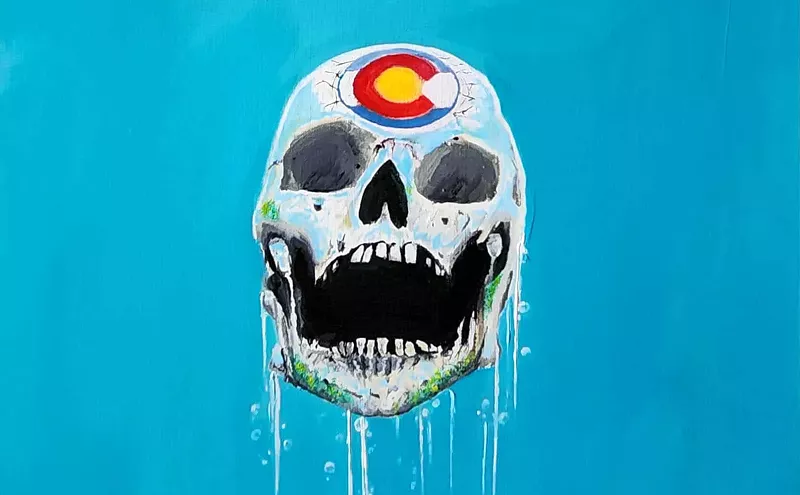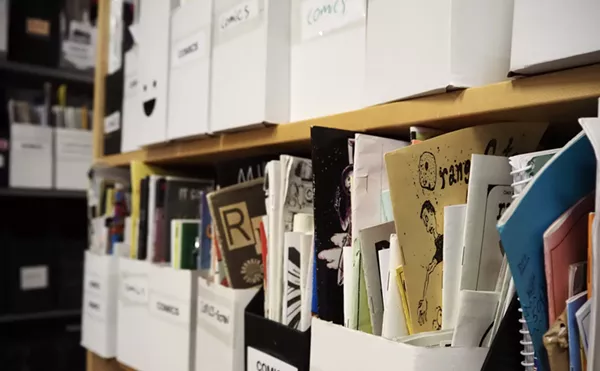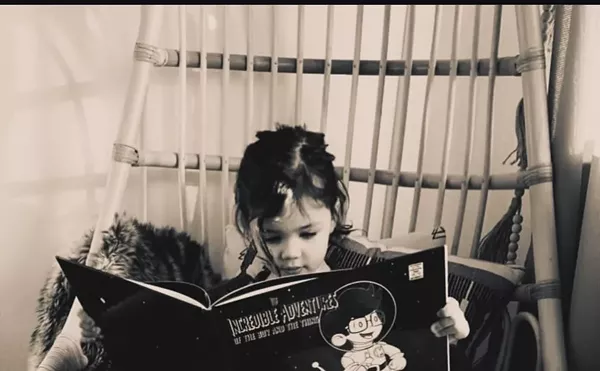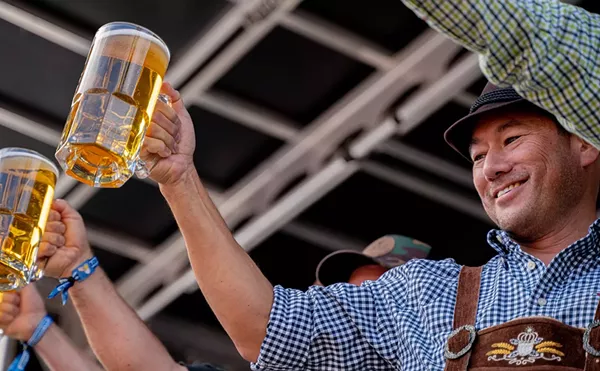For the past three decades, Marilyn Minter has produced images that are explicit, engaging, and up-close and personal as she explores human sexuality in popular culture while blurring the line between highbrow and lowbrow art. The New York artist's fascinating career is now being highlighted in a major retrospective opening this Friday, September 18, at MCA Denver.
A joint project of the Contemporary Arts Museum Houston and the MCA, Pretty/Dirty explores Minter’s glittery, often jarring world, one that crisscrosses pornography, fashion, feminism and fine art. From collaborating with Jay Z to buying a late-night TV spot to advertise an exhibition, Minter has continued to push the boundaries of what it means to be a contemporary fine artist. In advance of the retrospective's opening, Minter talked with Westword about it means to be an artist in 2015 — particularly one in the age of social media.
Westword: When you were looking at your own work over the last couple of decades to put Pretty/Dirty together, was there anything that struck you? Was there an element or theme you hadn't noticed before?
Marilyn Minter: I suspected that there was a constant thread — I was looking at these drawings I made when I was nine years old and I thought, Jesus, I'm doing the exact same thing! [Laughs.] It's the same kind of imagery. When the show came together, the work does look different over the years but there's a learning curve; you can see where I had to make this to then make that. One thing organically leads to another. I like the idea that there weren’t any big jumps here and there. Then there is also the fact that — and I had never noticed this before — there's a lot of pink and green. Those are the two colors that run through everything and that was a big surprise to me. Not bright pink or bright green, but a kind of grayish pink and grayish green that are pretty prevalent.
Were those what you might consider your "favorite" colors? I think about when we're kids and the question of "What is your favorite color?" is something we get asked like it's an absolute —
No, they weren't what I would have thought would be my favorite colors. I thought my favorite color was a kind of burgundy, so this was a real surprise. [Laughs.] It's really clear, too; in my earliest work, pink and green are there.
I read in a recent Vogue interview that you are a big user of social media platforms like Instagram and Twitter. I wonder, as an artist who was already very much established when these social tools came around, do you feel like having these things would have changed how you make or see art?
I am very curious and I'm not at all afraid of technology, unlike a lot of people my age. I went right to it — it wasn't even a gradual thing. I taught myself how to play video games early on — in the '90s, I was the best of anyone I knew at Tetris, you know? I knew I needed that foregrounding. I knew I needed to not be afraid to push buttons. Once I saw Photoshop, that was it — I thought I had died and went to heaven. I stopped drawing! [Laughs.] I did all my drawing on Photoshop.
That's interesting because even at my age — in my thirties — there's still this question of what art is "real" and how things like Photoshop play into the creation of what's "real"—
IRL (In Real Life). Right? It's always been with a learning curve, of course, but in my age group, I'm the best I know. I know people who are sixteen years old who are automatically going to be less timid and be faster and better. But it never was too intimidating to me. But there's a point when — I mean, I'm 67 — there's a point when I stopped learning Photoshop Five. I don't know the latest because I haven't taught myself that. But I have people who know it — it's amazing, I mean we just hired someone who just got out of school and she knows everything. I thought we were the best, but she came in and showed us all of this new stuff she had learned. There's still a learning curve — it just moves so fast.
"Controversial" is a word that comes up a lot when describing your work. I think that often, when art involves female artists or we make art that involves women — and especially, using the image of women's bodies — it automatically becomes "controversial," even when it's not.
Especially if you're young — when you're an old lady, you can do anything. There's this really famous Mapplethorpe photo of Louise Bourgeois holding a giant dildo, one of her sculptures. It's just adorable. But then look at what happens when Miley Cyrus does anything with a dildo? When you're post-menopausal, you can do anything. You're just adorable. It's pretty shocking, actually. And it's other women who are threatened by it, too. It's pretty frightening.
I think of the shaming aspect of it, too —
Yeah, the slut-shaming. It's shocking. But the Millennials are so much better than my age group, you know? They sort of stick together and I love that. They are really supporting one another as women and calling out things like slut-shaming. It's a new phenomenon. I was always trying to do it as artist — I kept trying to get the girls to work as a team, like the boys do. I was always saying, let's try to get to the top as a team and then try and kill each other off — like the boys do. Boys put each other in shows, they drink together, they hang out together and they go to each others' studios. I don't think women do that as much — they don't curate shows together.
I've always been trying to do it. I've always stayed real tight with my girlfriends, but I find it to be a struggle for my age group. We've managed to do it — I have successful girlfriend artists who are very inspirational for me. I go to their studios and see their work and think, damn, I better get started.
I like to think that I'm motivated by looking to my friends for inspiration, not competition.
Oh, no. It's competition. [Laughs.] But it's a healthy competition. The best compliment I can give my friends is, "I'm so jealous." And they say, "Oh, thank you."
Speaking of that, so often we are coined as "women" artists before we are considered any other kind of artist.
Well, I won't be the only woman in a show. I just won't do it. When a show is curated, it has to have other women in, too, or I won't do the show.
Which is a great stance to take because so often it feels like an afterthought. Like, "We've got this one token woman and/or one person of color in this show, so we're good."
It's a real statement to do that — like, "Okay, if we've got one woman and person of color, then we're all right." As long as there is someone who is "other." And that just doesn't work anymore.
What I personally love about your work is how you treat images of what is considered "girly." As a girl who grew up loving "girly" things and was later told to reject them because they made me a "less powerful woman," I really gravitate toward the way you approach color and texture, especially when it comes to make-up and fashion and the way you use women's bodies as subjects.
The place I'm controversial now is that I don't condemn glamor. It's so "shallow" and "debased"; fashion is so "fleeting" and art is so "sacred" — and I just think that's crap. I feel like that this is a billion-dollar industry and to ignore the power of it is really dangerous. I see the way that body image is being perpetrated. When I was growing up — and I hate when people say "back in the old days," but — the models were thin, but they looked like humans. This is just ridiculous now — the Photoshopping of all humanity out to create these robotic human beings. It's dangerous.
It's too easy to criticize the fashion world; it gives so many people so much pleasure, while at the same time making you feel like you're never going to look that good. That's what my work is all about — showing the paradox of all of this. I make things people find disturbing, but they are also really beautiful.
That's what draws me to your work — these elements of the girly and very real. It's interesting how long it took me to stop feeling bad for liking girly things while still considering myself a feminist.
You were shamed for it. But the Millennials will tell you that you can love both — they are the age group I feel like I should have been born into. [Laughs.]
I feel that way when I defend the idea of the selfie — I love the freedom to celebrate yourself and control your own image.
I do, too. That's why I've always gravitated toward women like Madonna and Pamela Anderson — they make a lot of money because they own their own agency. Pamela Anderson is a pin-up; that's how she makes her money. But she's not an Anna Nicole Smith or Marilyn Monroe, someone constantly being the victim of some Svengalis. They are using everything they've got to earn a living. Why not? If you can have power, why not? That's the most powerful thing in the world — owning your own sexuality. That seems to frighten a lot of people, and I don't understand why. I think it is healthier for everybody.
I've never been afraid of the future; I'm just a really curious person. I remember when I was a little girl and the World War II generation was complaining that TV was warping the youth. But I think television was just information, and I think it made my age group into these '60s revolutionaries — we had access to so much more information. We made our own decisions about race and politics instead of taking everything for granted. All of that "Patriotic, USA, rah rah rah" stuff, we didn't do that. It was a big shock to the American public.
When I was growing up, women and men who were married had separate beds on TV. [Laughs.] I've never seen that in real life.
Pretty/Dirty opens with a Pretty Glam party at 8 p.m. Friday, September 18, at the MCA; tickets are $45 for general admission, $35 for museum members. A VIP reception and curator’s tour of the exhibition begins at 6:30 p.m.; tickets are $125. To purchase party tickets or for more information on the retrospective, which runs through January 31, visit the MCA's website.

Audio By Carbonatix
[
{
"name": "GPT - Billboard - Slot Inline - Content - Labeled - No Desktop",
"component": "23668565",
"insertPoint": "2",
"requiredCountToDisplay": "2"
},{
"name": "STN Player - Float - Mobile Only ",
"component": "23853568",
"insertPoint": "2",
"requiredCountToDisplay": "2"
},{
"name": "Editor Picks",
"component": "17242653",
"insertPoint": "4",
"requiredCountToDisplay": "1"
},{
"name": "Inline Links",
"component": "18838239",
"insertPoint": "8th",
"startingPoint": 8,
"requiredCountToDisplay": "7",
"maxInsertions": 25
},{
"name": "GPT - 2x Rectangles Desktop, Tower on Mobile - Labeled",
"component": "24956856",
"insertPoint": "8th",
"startingPoint": 8,
"requiredCountToDisplay": "7",
"maxInsertions": 25
},{
"name": "Inline Links",
"component": "18838239",
"insertPoint": "8th",
"startingPoint": 12,
"requiredCountToDisplay": "11",
"maxInsertions": 25
},{
"name": "GPT - Leaderboard to Tower - Slot Auto-select - Labeled",
"component": "17676724",
"insertPoint": "8th",
"startingPoint": 12,
"requiredCountToDisplay": "11",
"maxInsertions": 25
}
]

